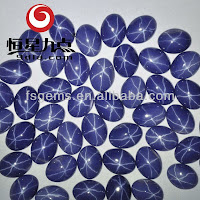 | ||
| The Star of India is a 563.35 carat (112.67 g) Star Sapphire |
Genuine Star Corundum (Sapphires and Rubies) are incredibly beautiful and interesting gemstones, and rare and expensive. Synthetics are very inexpensive to produce and are very common! How can you tell the difference? For starters, synthetic stars will be "perfect", with very little or no irregularities and extremely sharp stars. Natural Star gems are irregular and imperfect, and the stars will be "wavy" and uneven in length and brightness. But some newer, better quality synthetic Star gems are now on the market---see pictures below!
Blue Star Sapphire displays a three-ray, six-point star. These star sapphires are cut in a smooth domed cabochon to showcase the effect. The star is most visible when illuminated with a single light source:, such as a flashlight or bright sunlight, and the star moves across the stone as the light moves. This effect, called asterism, is caused by light reflecting off tiny needle like rutile (called "silk") arranged in three sets of parallel needles that intersect one another at 60 degree angles.
Star Sapphire is usually found in blue colors, but there are also various shades of brown and green that are called Black Star Sapphire. Orange and Yellow Star Sapphires are almost unknown, and very rare. Color Changing Star Sapphires are even more rare.
 |
| From Alibaba--fakes at $.10 a piece |
The value of genuine star sapphires is influenced by at least these two things: 1) the intensity and attractiveness of the body color, and 2) the strength and sharpness of the star. Of course all six legs should be fairly straight and equally prominent. Star sapphires rarely have the combination of a fine translucent or transparent color and a sharply defined star.
HOW TO SPOT A FAKE
There are a LOT of fake Star Sapphires being produced in China and Thailand right now. The same Etsy seller who sells huge "Kunzite" and "Paraiba Apatite" (what? Paraiba is a tourmaline, not Apatite) for about $100 (and the same glass stone jewelry on ebay for $20) is now also offering fake Star Sapphires. Watch out!!
There are synthetics called "Lindy" or "Linde" Star Sapphires and are marked with an "L" on the bottom of the stone, so that's a surefire giveaway that this is a synthetic stone! Millions of these Lindy stones were manufactured in the mid-20th Century. But there are also many fakes that aren't marked at all. So how can you tell?
- If the star is too "perfect" and the color is too blue, it's not genuine. A natural sapphire's "legs" aren't all identical; some are brighter, longer or straighter than others.
- Natural Star Sapphires have visible imperfections within the stone.
- If the bottom of the cabochon is smooth and flat, it's fake. A natural sapphire will be rough on the bottom, or even have missing "chunks".
- A fake's star will stay stationary when shining a flashlight on it and moving it in a circle! A genuine star sapphire's "star" will follow the light source! This is the easiest test!
- Best test: take it to a gemologist who will do a thermal conductivity test. Or, send the stone to a certified Gemologist and ask for a Gem Identification Report.
| Lab Created Star Sapphires: Look Great from the Front, but Flat Backs Are Giveaways. Pretty Though! |
 |
| You can see imperfections, and the star isn't perfect. |
 | ||
| Natural Star Sapphire--Not Perfectly Round... |
 |
| Same Natural Stone from Side |
Lindy Star Synthetics:
 |
| Original Lindy Star, 1950s--Too Blue, Round, Smooth |
 | |
| Asian Produced Lindy Star--Fake Star, Too Smooth |
No comments:
Post a Comment
*** NOTE: IF YOU WANT A RESPONSE, HAVE A QUESTION or WANT TO SEND PICTURES, please email me directly at:
InVogueBlogger@gmail.com and I will get back to you asap! IT IS THE ONLY WAY TO REACH ME! Thank you.
Note: Only a member of this blog may post a comment.